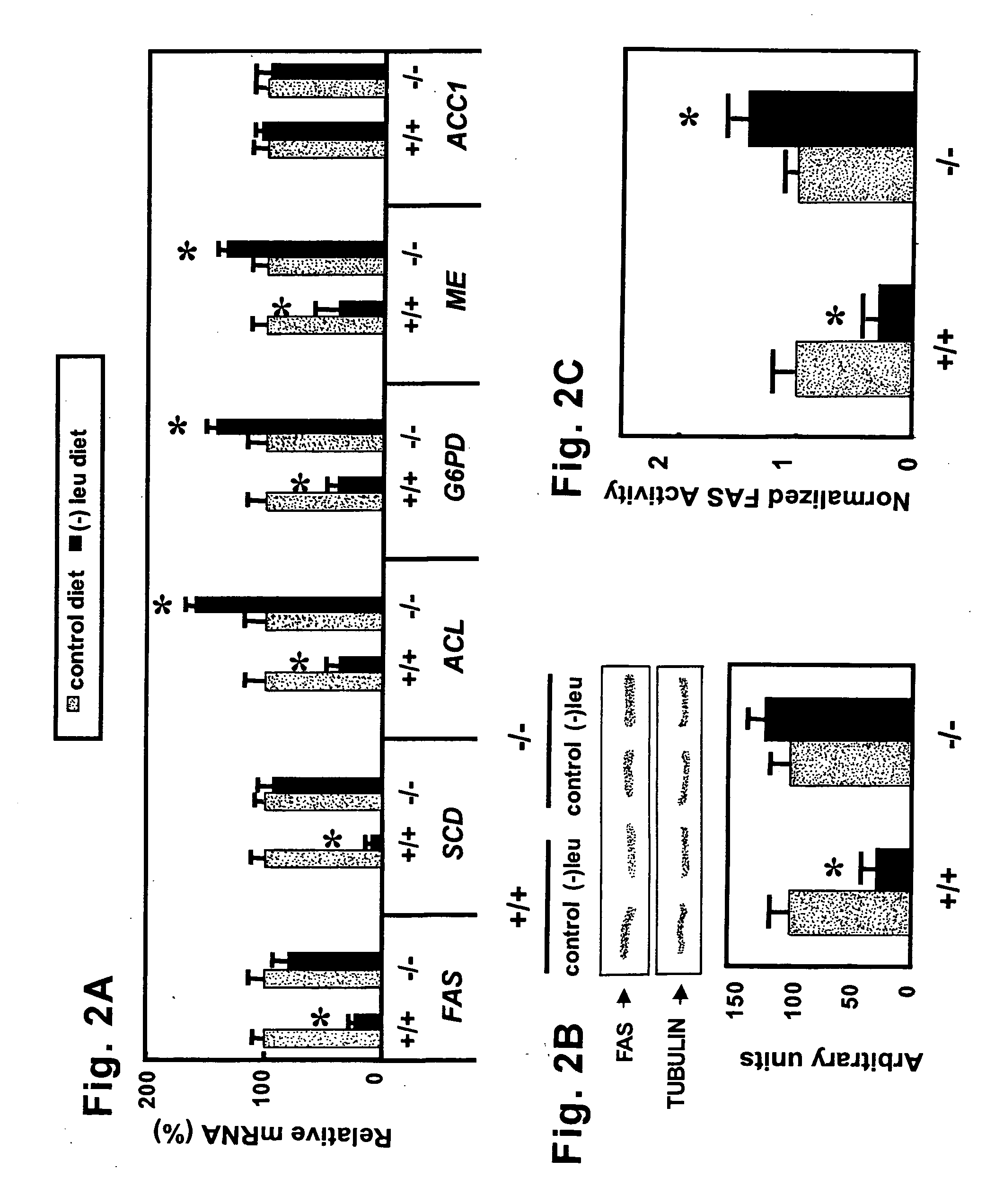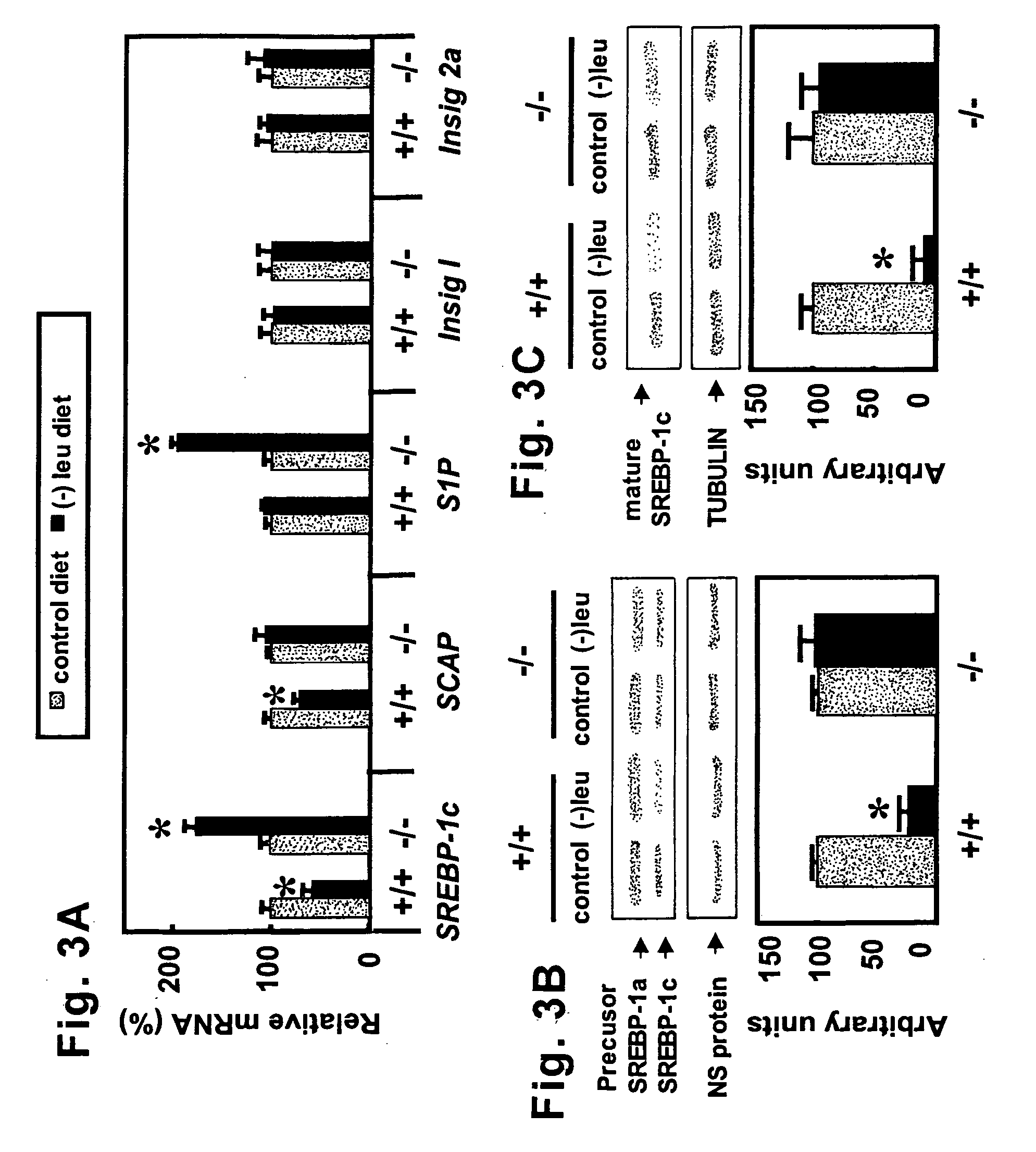Methods for reduction of adipose tissue mass
a technology of adipose tissue and mass reduction, which is applied in the direction of drug composition, peptide/protein ingredients, metabolic disorders, etc., can solve the problems of difficult to achieve, serious public health problems, and obesity as leading public health problems, so as to improve glucose tolerance and glucose clearance. the effect of reducing serum insulin levels and reducing the risk of obesity
- Summary
- Abstract
- Description
- Claims
- Application Information
AI Technical Summary
Benefits of technology
Problems solved by technology
Method used
Image
Examples
example 1
Leucine Deprivation Results in Radical Changes in Liver and Adipose Tissue Mass
[0099]GCN2+ / + and GCN2-mice were maintained on either a control diet or a diet lacking of leucine for 17 days. Leucine deprivation resulted in a reduction in food intake and body weight in both GCN2+ / + and GCN2− / − mice (Table 1A). GCN2+ / + mice fed the leucine deprived diet for 17 days experienced a 48% loss of liver mass and a dramatic 97% loss of abdominal adipose mass, whereas GCN2− / − mice showed no apparent loss of liver mass and much less severe loss of adipose tissue (69% reduced) compared to mice fed the control diet. A second leucine-deficient feeding experiment was conducted for a period of seven days (Table 1B) to better assess the more immediate effects of leucine-deprivation. Liver mass was similar in GCN2+ / + mice fed leucine-deprived diet compared to control diet during this shorter period, whereas adipose tissue was reduced by more than half. In contrast, liver mass was significantly increase...
example 2
GCN2− / − Mice Display Severe Liver Steatosis Fed a Leucine-Deprived Diet
[0100]The livers of GCN2− / − mice fed a leucine-deficient diet for 7 days appeared very pale, suggesting severe liver steatosis. The observation was confirmed by histological examination of the liver revealing extensive lipid deposition manifested as macro- and microvesicular steatosis (FIGS. 1A and B). Leucine deprivation had no effect on total cholesterol in the liver in either strain of mice. By contrast, leucine deprivation dramatically increased liver triglycerides in GCN2− / − mice compared to GCN2+ / + mice (Table 1B). As observed for liver, cholesterol in serum was not affected by leucine deprivation in either GCN2+ / + or GCN2− / − mice. Leucine deprivation significantly reduced triglycerides levels in serum in GCN2+ / + mice, and significantly more reduced in GCN2− / − mice. Leucine deprivation resulted in significantly decreased free fatty acids in the serum in GCN2+ / + mice; in contrast, fatty acid levels increased...
example 3
Genes Related to Triglyceride Synthesis are not Repressed in GCN2− / − Mice Fed a Leucine-Deprived Diet
[0101]The accumulation of hepatic triglycerides in GCN2− / − mice fed a leucine-deprived diet is likely to reflect an imbalance in hepatic triglyceride synthesis, β-oxidation, uptake and / or secretion of fatty acids. For this reason, levels of mRNA expression for proteins related to each of these processes were examined. It was first investigated whether genes underlying the synthesis of triglycerides are differentially regulated in GCN2+ / + and GCN2− / − mice during leucine deprivation. These proteins included acetyl CoA carboxylase (ACC)1 and fatty acid synthase (FAS), which together catalyzes rate-limiting step in production of palmitate 16:0; stearoyl CoA desaturase (SCD), which catalyses the synthesis of oleic acid (18:1, n−9); ATP-citrate lyase (ACL), which catalyzes the conversion of citrate to CoA and oxaloacetate, and glucose-6-phosphate dehydrogenase (G6PD) and malic enzyme (ME),...
PUM
| Property | Measurement | Unit |
|---|---|---|
| time | aaaaa | aaaaa |
| time | aaaaa | aaaaa |
| time | aaaaa | aaaaa |
Abstract
Description
Claims
Application Information
 Login to View More
Login to View More - R&D
- Intellectual Property
- Life Sciences
- Materials
- Tech Scout
- Unparalleled Data Quality
- Higher Quality Content
- 60% Fewer Hallucinations
Browse by: Latest US Patents, China's latest patents, Technical Efficacy Thesaurus, Application Domain, Technology Topic, Popular Technical Reports.
© 2025 PatSnap. All rights reserved.Legal|Privacy policy|Modern Slavery Act Transparency Statement|Sitemap|About US| Contact US: help@patsnap.com



